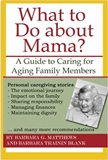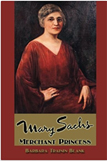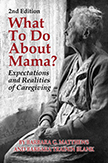
What to Do About Mama
Everyone is a potential caregiver.
Fifty-four million Americans already serve as unpaid caregivers to family members, and that number is likely to grow as the population continues to age.
Two-thirds of these caregivers are women—many of them in the “sandwich generation," simultaneously caring for both children and older family members.
This book offers guidance to present and future caregivers—based on the real-life experiences of the authors and other caregivers who have openly and honestly shared their joys and heartaches. It isn't a book by “experts,” but by people in the trenches—to help you develop realistic goals and expectations and strategies to keep your sanity through the trials and tribulations of caregiving.
Your experiences may be similar to or different from those of the caregivers featured here, but their stories are likely to resonate with anyone who has cared for a loved one—or might.

Mary Sach's Merchant Princess
At a time when women rarely went into business for themselves, Mary Sachs, an immigrant from a poor family with little formal education, became perhaps the most successful entrepreneur in her adopted city of Harrisburg, Pa., and beyond. She opened her first retail store in Harrisburg, selling upscale women's clothing in 1918, but expanded it to include several departments. Stores in Lancaster and Reading followed. Known as the "Merchant Princess," she revolutionized retailing, by setting customers up in individual booths and bringing clothes to them. But Sachs also won accolades for her charitable works, earning a second moniker as the "Princess of Philanthropy." She was most active in the Jewish Community Center of Harrisburg and other Jewish organizations but donated ecumenically to serve many causes. Eleanor Roosevelt, a personal friend, declared that "few can ever match" her generosity.
Buy on Amazon

What to Do About Mama
Since the first edition of this book came out in 2013, the needs it addresses have only intensified. Our population continues to age, and more and more people are caring for family members who are ill or have mental or physical challenges. Sometimes they care for multiple generations at once. Caregiving is something most of us are poorly prepared for, and we need all the guidance we can get. What to Do about Mama? offers guidance to present and future caregivers—based on the pragmatic and emotional “real-life” experiences of the co-authors and other caregivers who have openly and honestly shared their challenges, their heartaches, and their joys in caregiving. It isn't a book by "experts," but by regular people in the trenches—people like you. This book will help you develop realistic goals, expectations, and strategies to keep your sanity through all the trials and tribulations of caregiving. A new chapter added to this second edition, “The Aftermath of Caregiving,” examines ideas for how to meet the future caregiving needs of those in our care, while lightening avoidable burdens. Your experiences may be similar to or different from those of the caregivers featured here, but their stories are likely to resonate with anyone who has cared for a loved one—or will in the future.
Barbara has written a number of plays, some of which are available on the Senior Theatre Resource website
If you can tell stories, create characters, devise incidents, and have sincerity and passion,
it doesn’t matter a damn how you write.
– Somerset Maugham


